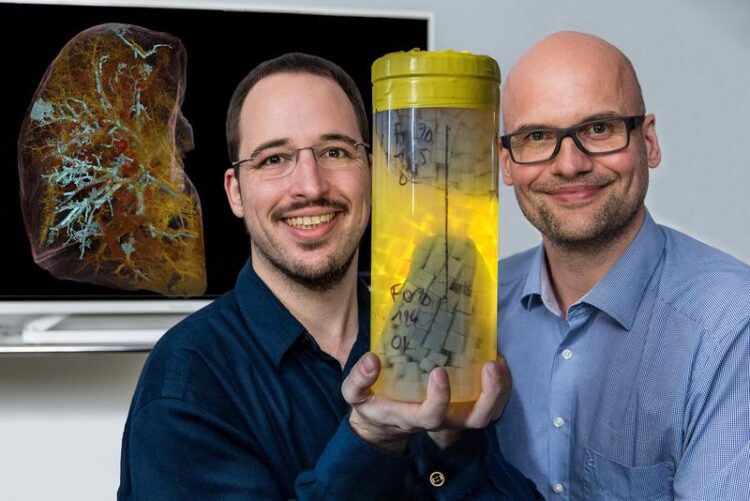New X-ray technique shows vascular damage in intact COVID-19 lungs for first time

Professor Dr. Danny Jonigk (right) and Christopher Werlein with the left upper lobe of a COVID-19 deceased in a special container suitable for measurement in HiP-CT.
Copyright: Karin Kaiser / MHH
Research team confirms blood vessel changes caused by infection with SARS-CoV-2.
When the SARS-Cov-2 coronavirus enters the lung, it causes massive tissue damage. A characteristic consequence of the infection is, among other things, the blockage of the pulmonary vessels due to a locally excessive blood clotting. Now, an international research team led by Professor Dr. Danny Jonigk and Christopher Werlein from the Institute of Pathology at the Hannover Medical School (MHH) and PD Dr. Max Ackermann from the University Medical Center Mainz has been able to demonstrate for the first time, using a highly innovative X-ray technique in a non-destructive manner, that severe COVID-19 causes massive remodelling of the finest blood vessels by causing normally separate blood systems to join together with unusual frequency.
For this purpose, the researchers examined the lungs of a COVID-19 victim in cooperation with the European Synchrotron Research Facility (ESRF), the world’s third largest particle accelerator in Grenoble, France. Thanks to the latest technology, a three-dimensional image of the complete organ could be generated for the first time using high-resolution X-rays. The work has resulted in two publications in renowned journals: The technical procedure is published in Nature Methods, the clinical application in the American Journal of Respiratory and Critical Care Medicine (Blue Journal).
HiP-CT shows an entire organ three-dimensionally without damaging it
The new X-ray technique works much like a computed tomography (CT) scan in a hospital. However, the resolution is a hundred times higher. “In the CT scan, we can show blood vessels in the millimetre range,” Professor Jonigk explains. The new technology called Hierarchical Phase Contrast Tomography (HiP-CT) is able to image the finest vessels with a diameter of five micrometres – about one tenth the thickness of a hair. HiP-CT makes it possible to penetrate into the depths of the lungs and depict even the smallest structures down to individual cells. “Until now, this resolution was only possible with a microscope, but only in two dimensions and for small tissue samples,” says the lung specialist. HiP-CT can do much more. With the new technique, it is possible for the first time to image an entire organ three-dimensionally and greatly magnified without damaging it. “This made it possible to examine structures that are at the limits of resolution and to gain an overview of the changes in the entire lung tissue,” emphasises the pathologist.
COVID-19 leads to “short circuits” in the blood vessels of the lung
In this way, the scientists discover what seems to go wrong with COVID-19. There are two separate blood systems in the lungs – one belongs to the pulmonary circulation and is responsible for supplying oxygen to the entire body, the other supplies the lung tissue itself with the vital gas. In a healthy lung, there are sometimes a few connections between small vessels of the two systems. In the damaged COVID-19 lung, on the other hand, the two blood systems formed numerous such cross-links in many areas. “This large number of irreversible shunts acts like a wide-open sluice gate and ensures that the oxygen supply in the entire body no longer functions,” explains Professor Jonigk. He suspects that the cause is a dysregulation of the lung itself, which thus tries to compensate for the lack of oxygen caused by the SARS-CoV2 infection in the short term in a kind of short-circuit reaction.
The brilliant, high-resolution technology will revolutionise medical imaging and our understanding of the structure of our bodies, says Professor Jonigk. “Now we have the ability to visualise tiny structures three-dimensionally in their proper spatial context on a large scale,” he explains. The research team has already begun to create a more advanced organ atlas. In addition to the COVID-19-damaged lung, it already contains images of several healthy human organs such as the brain, lungs, heart, kidneys and spleen from deceased body donations. The pathologist is also convinced that the HiP-CT X-ray technology will provide new insights into numerous diseases, including cancer and Alzheimer’s disease.
The work was done in cooperation between the MHH Institute of Pathology and, among others, the German Centre for Lung Research in Hanover (DZL Breath), University College London and the University Medical Center Mainz.
SERVICE:
For further information, please contact Professor Dr Danny Jonigk, jonigk.danny@mh-hannover.de, telephone (0511) 532-9532.
The original papers can be found here https://www.nature.com/articles/s41592-021-01317-x
Media Contact
All latest news from the category: Medical Engineering
The development of medical equipment, products and technical procedures is characterized by high research and development costs in a variety of fields related to the study of human medicine.
innovations-report provides informative and stimulating reports and articles on topics ranging from imaging processes, cell and tissue techniques, optical techniques, implants, orthopedic aids, clinical and medical office equipment, dialysis systems and x-ray/radiation monitoring devices to endoscopy, ultrasound, surgical techniques, and dental materials.
Newest articles

Superradiant atoms could push the boundaries of how precisely time can be measured
Superradiant atoms can help us measure time more precisely than ever. In a new study, researchers from the University of Copenhagen present a new method for measuring the time interval,…

Ion thermoelectric conversion devices for near room temperature
The electrode sheet of the thermoelectric device consists of ionic hydrogel, which is sandwiched between the electrodes to form, and the Prussian blue on the electrode undergoes a redox reaction…

Zap Energy achieves 37-million-degree temperatures in a compact device
New publication reports record electron temperatures for a small-scale, sheared-flow-stabilized Z-pinch fusion device. In the nine decades since humans first produced fusion reactions, only a few fusion technologies have demonstrated…





















